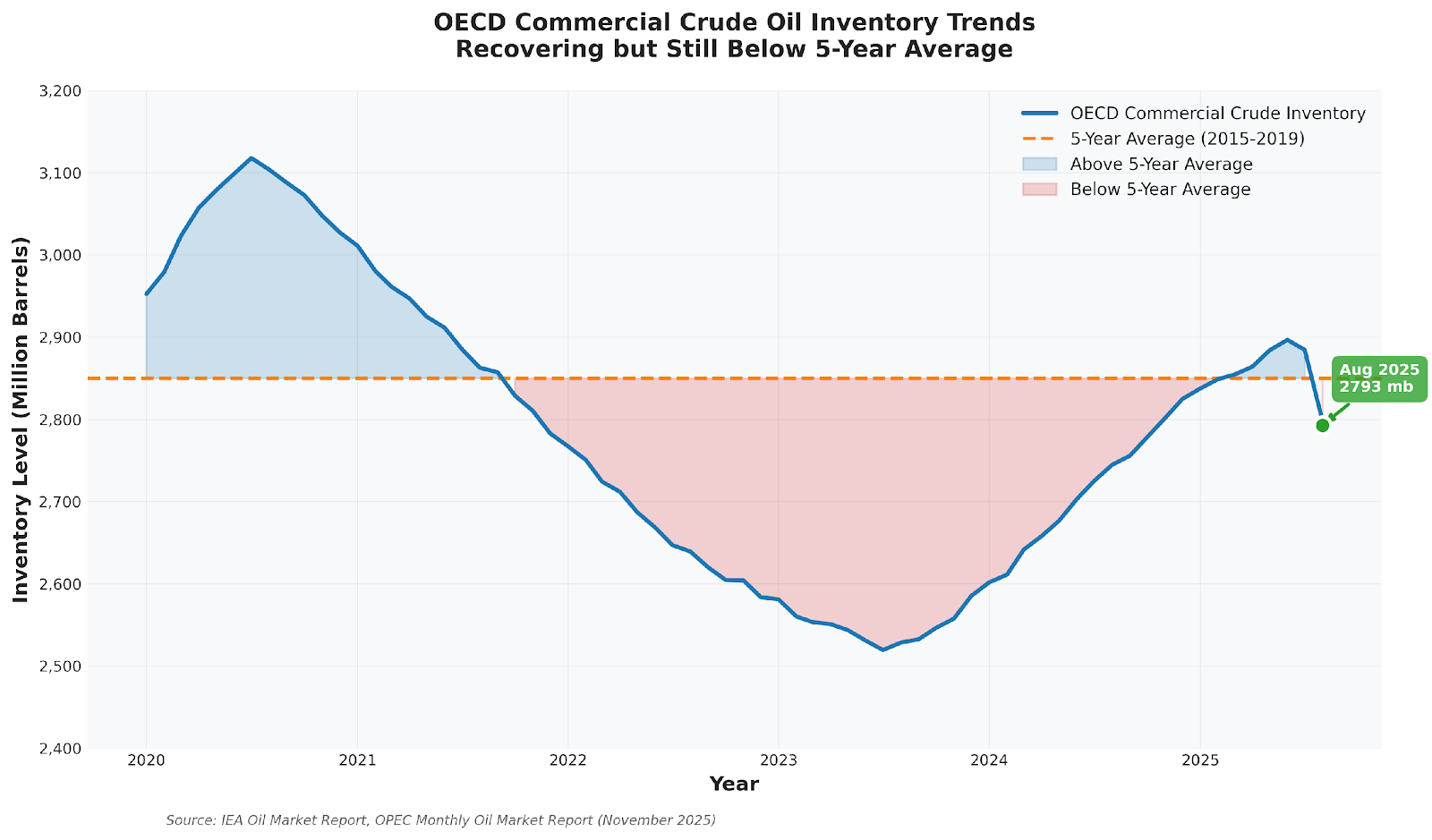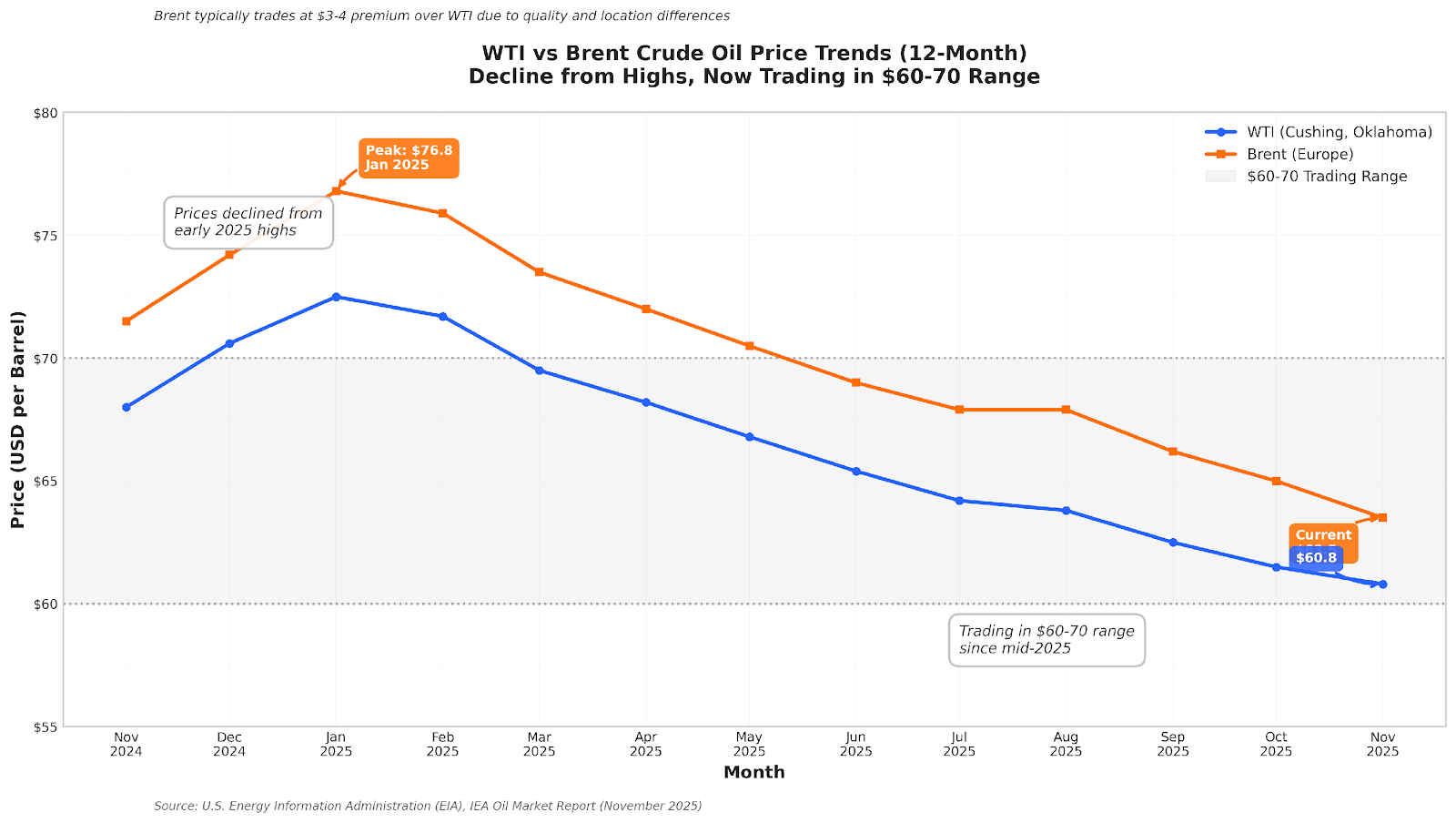市场资讯及洞察
.jpg)
摘要
IEA 最新月报显示,全球石油需求增速放缓但仍具韧性。尽管库存持续回升,但 OECD 库存整体仍低于五年均值,市场对供应中断高度敏感。OPEC、IEA、EIA 均上调非 OPEC 供应,未来可能出现“松中带紧”的供需结构。原油价格在供应宽松预期与地缘扰动之间反复震荡,波动率下降但敏感度上升。油市表现也可能通过风险偏好外溢至能源板块、商品货币及相关市场。
一、全球原油供需前景:IEA 月报核心要点
国际能源署(IEA)最新原油月报显示,全球石油需求虽较去年降温,但整体依旧保持韧性 [1]。先进经济体消费表现好于预期,有效抵消部分新兴市场的疲弱需求。IEA 预计 2025–2026 年全球石油需求将保持温和增长。然而在供应方面,如果 OPEC+ 维持当前产量政策且需求不出现明显下滑,全球石油市场未来数个季度可能重新进入“边际紧平衡”状态。IEA 同时指出,高油价、全球经济放缓、电动车渗透等因素正在逐步压制需求增速,使油市呈现出“短期紧平衡、长期温和宽松”的结构。
二、多机构观点对比:OPEC、EIA 与 OECD 数据
三大机构对于未来市场平衡的看法存在显著差异,这主要源于对非 OPEC+ 供应增长和需求韧性的不同假设。总体来看,市场普遍认同未来供应将更加充裕,但对于过剩的规模和时间点存在分歧。

图 3:三大机构对 2025-2026 年需求与供应增长的预测对比,显示供应增长普遍超过需求增长,预示市场将进入供应过剩周期。
OPEC 的观点相对乐观。OPEC 预计 2025 年全球石油需求将增长约 130 万桶/日,2026 年略高至 140 万桶/日 [2]。与此同时,OPEC 在最新报告中连续上调非 OPEC 供给预期,并首次将 2026 年市场从“短缺”调整为“小幅过剩”,反映其判断未来供应增长可能快于需求。
EIA 的判断更偏向供应充裕。EIA 上调了美国页岩油产量预测,指出 2025 年美国原油产量将创历史新高。同时,全球供应预期被上调至日均 1.06 亿桶,高于全球消费的 1.041 亿桶,意味着未来库存可能持续累积 [3]。EIA 预期 2025–2026 年库存增加将对油价形成中期压力。
OECD 库存虽然持续回升,但仍低于五年均值。IEA 数据显示,今年全球观测库存前八个月净增约 2 亿桶,但 OECD 商业库存仍比五年均值低约 6700 万桶。整体来看,库存虽然恢复,但仍处历史偏低区间,使油市对供应中断的敏感度依旧很高。

图 1:OECD 商业原油库存近 5 年对比最新水平,显示库存虽有回升但仍低于五年均值。
三、原油价格走势:WTI 与 Brent 如何消化预期
2023 年下半年,布伦特因供应紧张和地缘冲突预期一度突破每桶 90 美元。然而进入 2024–2025 年,随着供应回升和库存恢复,油价整体震荡下移。近期价格承压主要来自供应过剩预期强化以及美国库存意外上升。

图 2:WTI 与 Brent 价格从 2025 年初的高位回落,近期在 60–70 美元区间震荡。
尽管地缘事件偶尔推升价格,但反弹难以持续,因为供应宽松的结构性预期迅速重新主导市场。WTI 与 Brent 的期限结构一度出现小幅 Contango,显示短期供应充裕压制近端价格,而远月因长期需求预期而保持相对坚挺。整体来看,油市呈现低波动、弱趋势但对消息高度敏感的特征。
四、驱动油市的关键变量:地缘政治与供应端不确定性
运输通道风险仍是油市最大的潜在冲击点之一。全球三分之一海运原油经过霍尔木兹海峡,一旦受阻便可能引发油价剧烈波动。衍生品定价显示断供概率虽低,但属于典型的“低概率、高冲击”事件。
OPEC+ 的政策滞后性也带来结构性波动。减产会压低库存、推高价格,但高油价又刺激非 OPEC 增产,使市场重新宽松。美国页岩油增速放缓进一步加剧供应端的不确定性,削弱其作为“摇摆产能”的角色。此外,俄罗斯、伊朗等国因制裁和冲突导致出口波动,更加剧油市敏感性。
五、油市变化的外溢影响
能源板块通常与油价同方向变动,但反应速度较油价更平缓。油价对风险偏好的溢出效应也容易影响澳元等商品货币。大宗商品价格上行往往提升商品出口国的贸易条件与风险情绪,而价格下跌则可能压制相关货币表现。
六、原油市场风险提示
- 数据发布风险: EIA 每周库存、IEA 与 OPEC 月报可能导致短线波动。
- 地缘政治风险: 产油区冲突、海运通道中断、制裁变化均可能影响供需平衡。
- 宏观风险: 利率政策、美元走势及全球经济增速变化都可能改变需求前景。
结语
IEA 最新展望显示,全球油市进入“边际紧平衡”阶段:库存修复但仍偏低,供应端不确定性大于需求端。在这种结构性环境下,油市会对政策、地缘事件与供给变化表现出高度敏感。理解供需框架、关注库存趋势与识别关键风险,将是未来判断油市走向的关键。
参考资料
[1] IEA (International Energy Agency). (2025, October). Oil Market Report - October 2025. https://www.iea.org/reports/oil-market-report-october-2025
[2] OPEC (Organization of the Petroleum Exporting Countries). (2025, November). Monthly Oil Market Report. https://publications.opec.org/momr
[3] EIA (U.S. Energy Information Administration). (2025, November). Short-Term Energy Outlook. https://www.eia.gov/outlooks/steo/


Please find the recording of this weeks Inner Circle session below "Using Autochartist on MT4/5 to identify opportunities & create a trading system" to review at your convenience. Ilan was not only generous in giving his time to share the power of Autochartist as a trading tool but gave invaluable insights into his own trading experiences and system. Autochartist is provided FREE to all Go Markets clients with a trading balance of $500 or more and you can add it to your MT4/5 platform in your client portal. https://vimeo.com/387889058 Mike Smith Educator GO Markets Disclaimer The article ad video from GO Markets analysts is based on their independent analysis.
Views expressed are of their own and of a ‘general’ nature. Advice (if any) are not based on the reader’s personal objectives, financial situation or needs. Readers should, therefore, consider how appropriate the advice (if any) is to their objectives, financial situation and needs, before acting on the advice.


Here if the recording of this week's Inner Circle session to review if you managed to attend or see for the first time if you were not able to make the session live. The principles covered are applicable across all trading vehicles. (click on the icon in the corner for full screen) https://vimeo.com/383786094 Please feel free to follow up with any queries you have by dropping an email to [email protected] Mike Smith Educator and course facilitator GO Markets Disclaimer The article from GO Markets analysts is based on their independent analysis. Views expressed are of their own and of a ‘general’ nature.
Advice (if any) are not based on the reader’s personal objectives, financial situation or needs. Readers should, therefore, consider how appropriate the advice (if any) is to their objectives, financial situation and needs, before acting on the advice.


Gold had been on a steady rally to the upside with the price climbing along the bullish trendline from the 1620 price level in November 2022 to reach a high of 1960 in February 2023. This move higher was driven by general market anticipation that the US Federal Reserve would pivot on its current monetary policy, slowing down or pausing future interest rate hikes sooner than expected. Fundamental Overview Last week, the US Federal Reserve, European Central Bank, and Bank of England increased their respective interest rates by 50bps.
With the central banks continuing to hike rates, and real yields rising again, gold could be viewed as a less attractive investment option. On Friday, the US non-farm employment change data was released stronger than expected at 517k (Forecast: 193k) and the US unemployment rate fell to 3.4%. This led to a significant recovery in strength for the DXY, with the price climbing to the 103 price area.
Technical Overview As the DXY strengthened, the negatively correlated Gold saw a sharp pullback, with the price trading down to the 1864.61 price level. The retracement in Gold saw it break through several key technical bullish elements, in particular, the bullish trendline from November, the 1900 round number support level, and the first Fibonacci retracement level of 23.6%, leading to the near-term technical outlook for Gold to shift from bullish to be short-term bearish. A deeper correction to the downside can be expected, as the Relative Strength Index (RSI) reversed strongly from the overbought region and through the 50.0 level.
However, the downside momentum could find support between the price range of 1800 and 1740 price range, formed by the 50% and 61.80% Fibonacci retracement levels respectively. Disclaimer: Articles are from GO Markets analysts and contributors and are based on their independent analysis or personal experiences. Views, opinions or trading styles expressed are their own, and should not be taken as either representative of or shared by GO Markets.
Advice, if any, is of a ‘general’ nature and not based on your personal objectives, financial situation or needs. Consider how appropriate the advice, if any, is to your objectives, financial situation and needs, before acting on the advice. If the advice relates to acquiring a particular financial product, you should obtain and consider the Product Disclosure Statement (PDS) and Financial Services Guide (FSG) for that product before making any decisions.


Market sentiment towards a currency pair, and hence price, changes when new information comes into the market. The most common situation that creates such a change is the release of economic data. These are planned in terms of timing to theoretically offer no market participant an advantage over another market participant.
Economic data revised For those of you who are less experienced traders it is worth pointing out three important points: a. Some economic data releases have the potential to make a greater impact on market sentiment than others. It is beyond the scope of this article to explore this in detail, however major data points include for example GDP, jobs data, CPI (inflation measure), and interest rate decisions. b.
It is not the number per se but rather the comparison against what is expected. There is a market consensus “baked into the price” already, a projection in other words, as to what is likely to happen to major data points. So, it is the closeness or otherwise to this expected figure that is the key factor.
A big miss in either direction is likely to have a far more significant impact on market sentiment than a figure that is at, or close to, expectations. c. Also, the importance of a data point is to some degree relative to the timeframe you are trading. For example, in a shorter-term position where you position higher but are aiming for a smaller Pip move to take profit, economic data is more important, than perhaps when trading a daily chart.
As a Forex trader, you have one key fact in your favour is that the time of these announcements is entirely predictable. What this means to you is that you can make a choice and “programme” into your trading plan potential action(s) when faced with the prospect of significant imminent data release. Your trading choices Assuming you already have a defined exit general strategy in place for open positions that includes having a trailing “stop” should a trade move in your desired direction, you have THREE potential choices to make.
Accepted good general trading practice would be that you “plant your flag” in one of these as your standard. Once you have planned and implanted this, then you can prospectively test the other two, to determine which is the optimum individual “fit” for you as a trader. Your three choices are: A.
To close any open positions that are likely to be impacted by the data release to remove the risk of loss from your existing dollar result in the position. Although reducing downside risk you are also risking losing fast upside potential, should price move quickly in the direction of your trade. B.
To do nothing new i.e. adhere to your normal trail stop strategy. In this case you have retained the opportunity of upside potential whilst increasing the dollar risk associated with your wider stop (compared to the next option) being triggered. It is worth bearing in mind with this, and the subsequent choice we will discuss, there is always chance of some slippage i.e. not been filled at expected order price.
The risk of this is that it’s highest with the often-higher volatility situation following data release. C. To tighten your normal approach to trailing a stop e.g., if your norm is to trail your stop to within 20 Pips you could choose to tighten to within 10 Pips of current price pre data release as part of your system.
What this means to you is that if a trend does reverse and trigger your stop it will be at a better level, whilst still giving you any upside potential. What these all mean to you: A. Articulate within your trading plan what is your primary approach and clear any unambiguous situations where you may vary this.
B. As stated before, choose to trade the approach that you prefer right now, and then compare potential results against the other two.


Before we start, this is one of those “tell-it-how-it-is” articles, so perhaps turn your sensitivity meter down a little and read this in the nurturing, supportive spirit in which it was written. It does involve some work for those who are serious about growing as a trader, so be warned it lays down a challenge to act. The bottom line is that you may have done the ‘technical’ learning, have the optimum trading plan on the planet, but many traders do NOT get the results that may be possible due to their level of trading discipline.
If one has planned an effective exit strategy, and position sizes appropriately, accepting that some trades will go against you, rarely do the major account draw-downs happen that many, many traders sustain unless you stray from your system. More commonly, and arguably almost invariably, major draw-downs are a result of ineffective systems (and if you have not got a trading plan in place, get one!) or poor discipline in execution. The reality is that one bad trade where discipline is noticeably absent can remove weeks or even months of positive results.
But there is another “trading beast” at play here, even if one doesn’t have the major draw-down in one or two trades, there is the insidious impact of regular “smaller” discipline issues that can nibble away at your account value over a period of time. It is the latter that is the focus of this article. Why this “counting the cost” approach?
The educational aim for this article, is to stimulate some evidence gathering that may indicate that something NEEDS to change in your trading. If we look to the academic work if what motivates changes, there is a principle of interest that could be relevant. Firstly, if we look to Motivational Hedonistic theory, this suggests that people (and that includes traders) are motivated to change by either pleasure (in this context positive trading results) or avoiding pain (or negative trading results).
The reality is, as stated previously, that many traders have this insidious reduction of account value, or as an alternative “bumble along” finding themselves in a small gain following by small loss cycle and never seem to move forward. This ‘middle ground’ neither causing the two extremes of trading pleasure or pain, may result in a complacency and fail to provide the motivation to take real and meaningful action to change results. In this case, a logical approach would be to do some work that produces the evidence and jolts the trader out of this minimal action state.
This is what the following exercise aims to do or in other words, we are going to try to create some pleasure or pain to be your motivator to take any action you need to. The idea is, if we can mirror those trades that followed what we planned to do (and take pleasure from that), and removed the execution errors (and so the pain created by that evidence), then we have the platform to change positively. 3 steps to create the trading motivation to change What you need before you start Ring-fence some time (after all your trading future could depend on it!) A critical mass of your latest trades to review (we suggest a minimum of twenty) Your trading platform to historically look at charts and the honesty to record “what happened”. Your bottom-line result on our account as a benchmark of what really happened.
Step 1 – Dividing your trades. Objectively look at the trades you have taken. Make two columns, dividing these into those which you adhered to plan (“1”) and those which you did not (“2”).
Remember, exits and position sizing are the key things to include, not only those when you let a loss run but also those where you cut a potential profit short in a trade in your “2” column ( not including pre-planned profit targets). Remember also to take a loss that did adhere to plan goes in column 1. Step 2 – Analysis stage 1 – The trading pain/pleasure overview Let’s start with some simple analysis.
Total the results from each column and make a judgement of what these totals mean on where your account could have been, your execution discipline and the level of pain or pleasure you feel when you look at each column. Step 3 – “Turning the screw” – Analysis stage 2 At a deeper level we can start to look at what would have happened in those trades in column 2, ONLY if you had executed as you should. Look back at those charts specifically and dependent on what you failed to execute, record what would have happened if you had positioned sizes appropriately, had a system stop in place (or not moved your original stop when you shouldn’t have), and if you hadn’t pressed the exit button too early when you should have adhered to your trail stop strategy fully.
In recording the difference of potential versus the reality, there may be the level of pain to create that “MUST DO” feeling to take appropriate and meaningful action going forward. To summarise, often we need to “ram home” what is happening in our trading to take the action to grow as a trader and increase the likelihood of improving results. Doing the suggested practical exercise may give you the impetus to not only stick to plan, but also consequently gain the opportunity to start objectively looking at how to improve that plan to better fit you as an individual trader.
And finally One final thought, many traders come into trading with the desire to do this for a lifetime. The risk therefore of NOT addressing this, is that you not only lose a large proportion of the original capital you put into the market, but ultimately for many traders, but because there has been inaction in putting right things you need to, their pain may lead them to remove themselves from the market and destroy the potential that a lifetime of trading could create. Mike Smith Educator GO Markets Disclaimer The article from GO Markets analysts is based on their independent analysis.
Views expressed are of their own and of a ‘general’ nature. Advice (if any) are not based on the reader’s personal objectives, financial situation or needs. Readers should, therefore, consider how appropriate the advice (if any) is to their objectives, financial situation and needs, before acting on the advice.


At last week’s Share CFD clinic webinar session on Thursday we discussed the current market response to Coronavirus and key technical levels that could be important. Clearly market reaction has been significant, market sentiment over the last week has given a clear sentiment message as to the adverse financial implications of Coronavirus. Of course, this type of reaction to a potential global health epidemic is not unusual - there are many such similar instances and consequent reactions through history of financial markets.
Historically, in terms of how equity markets move may be worth a little more discussion. The following points are worth consideration: There will be a point whereby the market comes to the belief that any such capitulation reflects the potential damage to the economy of any such event (and hence will cease to drop). While this is happening, markets look at not only key price levels of previous support and resistance but also perceive important other “landmarks” related to price action.
Any breach of these “landmarks” will often have market participants scurrying to find the next one to see if this is also breached. At the end of such a market response any “bounce” is often rapid. So, what are these “landmarks”?
There appear to be two types that get market attention namely: The degree to which price has fallen from recent highs What the key moving averages (50 and 200 are often used) are doing both in their relation to price and each other (i.e. whether they have crossed). With the former, these key levels and subsequent definitions often cited are; Pull back – up to 10% Correction 10-20% Bear market - >20% They may be related to indices, sectors and individual stocks. So, what happened?
If we look at the US500 (CFD associated with the S&P500) on a daily chart as this is what we can access on our MetaTrader platform (see below) there are a few interesting things of note from this week. Prior to Thursday session which we discussed at the webinar, the close for the previous day (and subsequent action pre-market) had the price testing both the 10% correction level and the 200 SMA (Simple moving average) at the 3054 level. As price approaches any such key level, there are two things that are often seen in trader behaviour: Up to the breach of such a key level there may be some caution selling off more than has occurred already (including taking new short positions) Once such a breach has occurred, this often precipitates more selling which we saw during Thursday’s US equity market session, taking the price down to the next logical level of potential support.
One final point of note. Clearly any index is made up of a ‘basket’ of different stocks from different sectors. In any market downturn or upturn where it has an economic implication, the so called “cyclical” stocks respond more significantly than traditionally defensive stocks.
Hence, these sectors e.g. basic material, microchips, consumer discretionary have tended to get hit hardest which may be over 15% down from highs and some even approaching bear market territory. Does Friday’s action mean that we have seen a bottom? In another volatile session for equity markets, we saw a low at 10am US EST, and a close near the highs of the session.
The candle showed what could be interpreted as a reversal candle with higher close than open and a long wick suggestive of a market rejection of a further move downwards. Three VITAL points here of note if you are considering whether this may be a ‘bottom’ forming. Experienced traders always wait for next candle confirmation before even beginning to consider a trend reversal may be taking place.
The nature of this market move is very headline driven, hence further headlines that indicate that things are changing adversely or otherwise are likely to have a “high risk”, significant short-term impact on sentiment as markets attempt to process new information. It is not untypical that at the end of any week where there has been a significant movement, that there is Friday profit taking. After a bullish week this may be traders taking profit in long positions (see gold this week as an example), or, as it could be in this case with Friday’s action, those who are short the equity markets closing down those positions for profit (hence pushing the price higher).
Clearly, the market will continue to give us messages but the main ones in terms of your trading (which we hope this article may have helped with) are: Having some understanding of what and how market sentiment may help your decision making There is no doubt that this is a higher than usual “risk environment”, irrespective of trading direction chosen or what instruments you are trading. Logically therefore, it is worth considering alterations in position sizing or even having a larger than usual amount of your trading capital (as much of the market now does), sitting on the sidelines. We will be discussing these issues further in this week’s webinar sessions ( including tonight’s Inner Circle ) which we would be delighted if you could attend, if you are not already part of this weekly education group you can join us at 7.30pm AEDT this evening HERE Send any comments or questions to [email protected] Trade safe Mike Smith Educator GO Markets Disclaimer The article from GO Markets analysts is based on their independent analysis.
Views expressed are of their own and of a ‘general’ nature. Advice (if any) are not based on the reader’s personal objectives, financial situation or needs. Readers should, therefore, consider how appropriate the advice (if any) is to their objectives, financial situation and needs, before acting on the advice.

